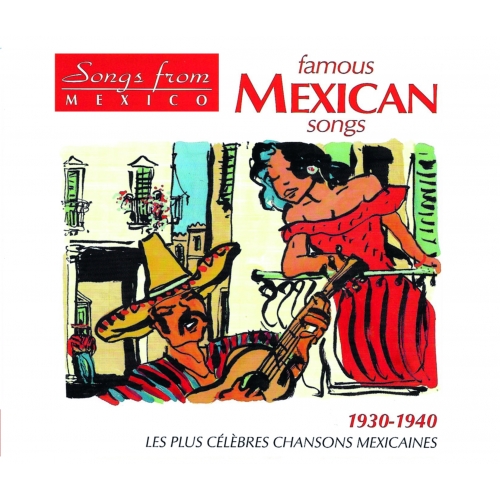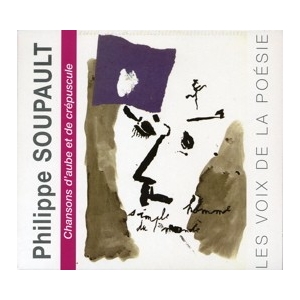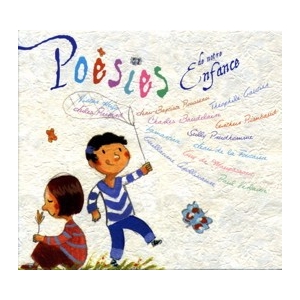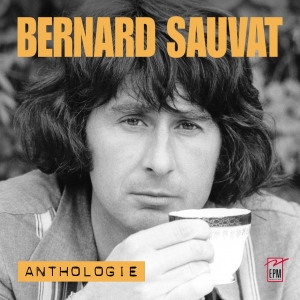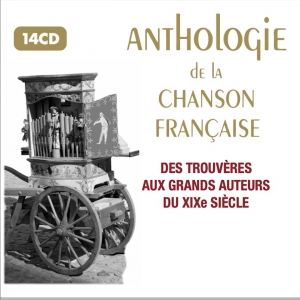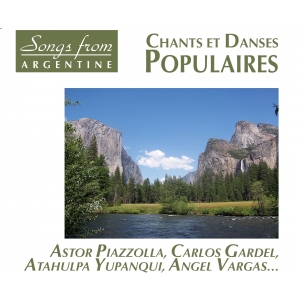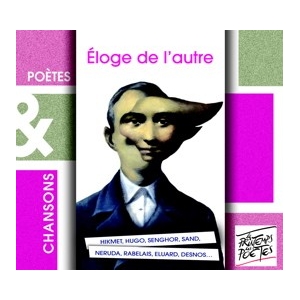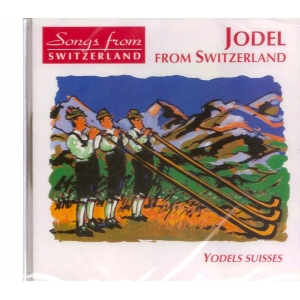MEXIQUE / CHANSONS POPULAIRES
1 CD rééditon
VOUS RECEVREZ UN BON D'ACHAT 10% À PARTIR DE 40 € DE COMMANDE
FAMOUS MEXICAN SONGS 1930 - 1940 1. El Tren (DP) son 4'01Mariachi Vargas
2. El Jarabe Tapatío (DP) mexican hat dance (instr.) 2'16Mariachi Vargas
3. El Gavilancillo (DP) son 2'50Mariachi Vargas
4. Lupita (DP) canción 3'12
Mariachi Vargas y Pepe Chabela
5. El Toro Viejo (DP) son 3'13
Mariachi Vargas
6. El Torero (DP) son 3'04
Mariachi Coculense "Rodriguez" de Cirilo Marmolejo
7. Ando Borracho (DP) canción 3'03Mariachi Coculense "Rodriguez" de Cirilo Marmolejo
8. La Güerita (DP) canción 2'54Mariachi Coculense "Rodriguez" de Cirilo Marmolejo
9. La Cucaracha (DP) corrido 3'05Grupo Nacional
10. Guadalajara (P. Guizar) canción 3'03Los Trovadores Latinos
11. Maria Bonita (Agustín Lara) canción ?Los Trovadores Latinos
12. La Adelita (DP) canción 3'17Roberto Rodriguez & Clemente Mendoza
13. Cielito Lindo (DP) canción/vals 3'03Roberto Rodriguez & Clemente Mendoza
14. La Elena (L. Hernández / L. Sifuentes) corrido 2'36Luis Hernández & Leonardo Sifuentes
15. Veracruz (Agustín Lara) bolero 2'56
Agustín Lara y su piano
16. Morena (Agustín Lara) bolero 2'41Alfonso Ortiz Tirado / Orquesta José Briseño
SONGS FROM MEXIC0
Chansons populaires du Mexique
Au Mexique, la chanson est le refuge privilégié de la tristesse et du désespoir. Les lyriques se rapportent à l'homme abandonné, rejeté, méprisé, à ses amours malheureux et contrariés. Le Mexicain sombre (haut) toujours dans le mélodrame surtout lorsqu'il entonne un boléro. Et il en entonne et en entend des dizaines coloriées par un style musical qui varie selon la région. Ces chansons sont accompagnées par une ou deux guitares, un piano, une harpe, ou par un orchestre de boléro (cuivres et cordes) ou encore par le célèbre ensemble appelé Mariachi (violons, harpe, guitarrons (guitare basse acoustique) et trompettes). Mariachi est un nom dérivé du mot français mariage. A l'époque du règne malheureux de Maximilien, que Napoléon III avait "placé" afin de contrecarrer les projets d'expansion territoriale des États-Unis en Amérique Centrale, ces mariachis accompagnaient les cérémonies.
C'est sur la mythique plaza Garibaldià à Mexico City qu'on tombe inévitablement sur des mariachis dans l'attente d'un engagement. Fêtes privées et banquets publics sont les destinations les plus courantes, mais l'habitude est encore répandue de remédier à un différent conjugal en revenant chez soi en compagnie d'un choeur qui chante à tue-tête. On paie des chansons pour se faire pardonner sa vieja aux yeux de sa belle... Le vrai mâle mexicain n'hésite jamais à claquer un mois de salaire pour une nuit de mariachis. Virilité oblige !
De son côté, la chanson engagée dite corrido imite les chansons de geste des romanceros espagnols. Seule différence : le chevalier combattant pour le Roi ou l'Église est remplacé par le bandido défendant le pauvre paysan ou le ranchero poursuivant sa vengeance.
La mythique Cucaracha parle de l'armée gouvernementale qui refuse d'avancer sans l'aide d'un ou deux joints de marijuana.Le Mexique est un pays vaste (environ sept fois la France). Aussi, afin de mettre en valeur l'idée d'espace de ce pays nous avons choisi le thème du train pour illustrer chaque fin de titre ou faire un "fondu" sur le titre suivant. Locomotive au loin, se rapprochant, arrêt en gare et souffleries structurent cette anthologie.
C'est dans les régions de Veracruz et de Jalisco que la multitude de rythmes mexicains trouve son idéal. Il serait plus juste d'ailleurs de parler de danses bien que la canción soit tout à l'honneur dans cette sélection. Mais la Guadalajara par exemple est devenue la danse nationale du Mexique, tandis que Cielito Lindo est une des chansons les plus interprétées au monde. Le Mexique est en bonne place dans les rêves de voyage et la carte postale sonore que voici vous plongera dans ces bars enfumés où les musiciens brandissent leurs guitares et attaquent une ballade ranchera. Apparemment elle est inoffensive et pourtant, il s'agit d'un message car dans les tripots, la musique est souvent utilisée à des fins opposées à celles de la chanson dédicacée. Ici, pas question d'amour. On paie des chansons pour provoquer, lancer un défi aux hommes de la table voisine. "Sacaremos ese güey de la barranca... Ce mec, on va le flanquer dehors!..." Et l'autre dédaigne... il se borne à lever un sourcil, à lisser sa moustache qu'on devine sous son grand sombrero norteño (geste typique du pinche güero, du couillon), tandis que les musiciens attaquent El Jarabe Tapatio, la danse du sombrero... Ay, ay, ay !!!
SONGS FROM MEXICO
Mexican popular songs are rooted in sadness and despair, the lyrics based on loneliness, rejection, scorn, unrequited love. Nowhere is this Mexican taste for melodrama more clearly illustrated than in the bolero, of which there are dozens, their musical style varying from region to region. These songs are often accompanied by one or two guitars, piano and harp, or by a bolero band (brass and strings), or by a Mariachi ensemble (violins, harp, guitarrons (acoustic bass guitar) and trumpets). The name “mariachi” comes from the French word “mariage”. During the unfortunate reign of Maximilian, whom Napoleon III had placed on the throne in an attempt to thwart the United States’ attempts to expand their territorial hold on Central America, these mariachis were played at all types of ceremonies.
Mariarchi musicians are always to be found in the famous Garibaldia Plaza in Mexico City, waiting to be hired to play mainly at private parties or public banquets. However, another widespread custom still persists — that of making up a quarrel with one’s wife or sweetheart by returning home at the head of a choir in full song, the culprit paying the singers to ask for forgiveness on his behalf. A true Mexican would not hesitate to blow a month’s wages on a mariachi night. Machismo demands it!
On the other hand, the corrido, or song with a message, imitates the historical epic poems of the Spanish romanceros, the only difference being that the knight fighting for the king or the church is replaced by the bandido defending the peasants or the ranchero in search of vengeance.
The ever-popular Cucaracha tells of the state army that refuses to advance without the aid of a few joints of marijuana.
As Mexico is such a huge country (seven times the size of France), to underline this idea of vastness, we have chosen the theme of a train to mark the end of each title or as a lead-in to the following one. The sound of an approaching train, getting nearer, stopping at a station, the blast of a whistle all provide the framework for this anthology.
The widest variety of Mexican rhythms is to be found in the Veracruz and Jalisco regions. Moreover, although place of honour is given to cancions in the present selection, we must not forget the dances for, while Cielito Lindo is sung throughout the world, the Guadalajara has become the national dance of Mexico.
You may have dreamt of visiting Mexico one day but, in the meantime, let yourself be transported by the music into a bar, thick with smoke. The musicians brandish their instruments and launch into a ranchero — seemingly inoffensive but conveying an underlying message and one in which there is no question of love. These songs, paid for by the customers, are intended to provoke, to challenge men sitting at a neighbouring table. “Sacaremos ese gêuy de la barranca … We’re going to chuck that guy out!” The other shrugs off the insult, merely raising an eyebrow, stroking his moustache that is just visible under his wide sombrero (a typical gesture of insult). Meanwhile the musicians move into El Jarabe Tapatio, the dance of the sombrero … Ay, ay, ay!!
Adapted from the French by Joyce Waterhouse

